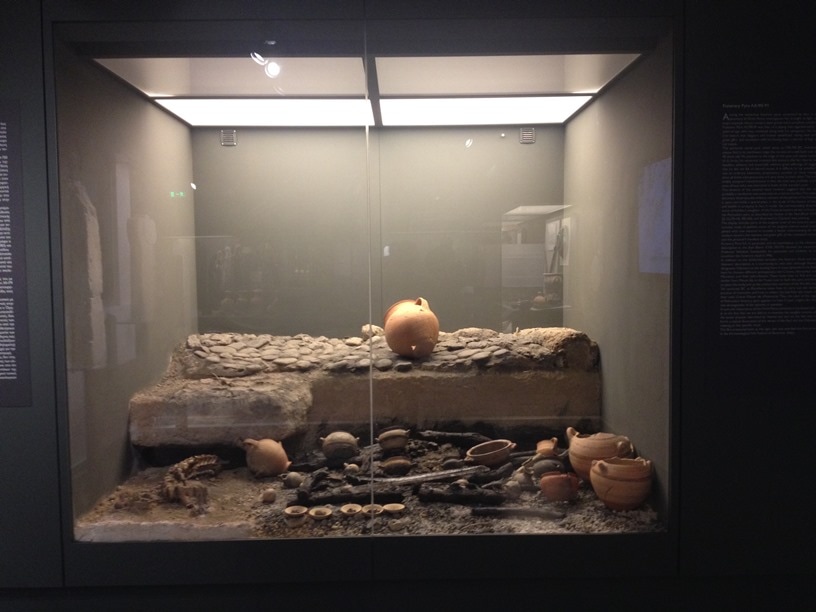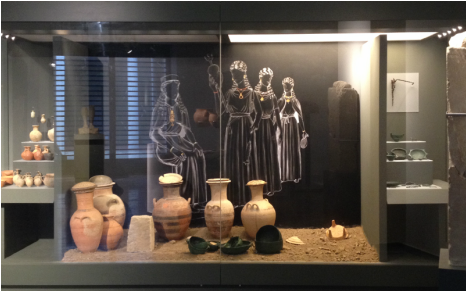Hall C is dedicated to Eleutherna’s cemeteries. The display, however, deliberately focuses on the finds from the Orthi Petra necropolis. With its cremation burials and rich finds, this cemetery is a reference point, as it illustrates the Homeric description of Patroclus’s funerary pyre (Iliad, Book XXIII), thus confirming its veracity, for which there was disagreement, even on the slaughter of the twelve Trojan prisoners, between Plato and Aristotle.
To date, two main burial practices have been identified in the Orthi Petra cemetery: cremations and interments. Cremations appear to have been employed almost exclusively for adult male warriors, as mentioned in the Iliad. The deceased were cremated on a wooden structure, together with their personal belongings and grave gifts. Their remains and some of the grave gifts were then placed in ash urns next to the funerary pyre or inside rock-hewn chamber tombs. The most important chamber tombs at Eleutherna are Tombs A1/K1 (Tomb of the Warriors) and A1 (Tomb of the ‘Kosmos’ and his Family). Originally, cremations were carried out in a cremation pit, but later, after the end of the eighth century BC, in separate funerary pyres at various locations, primarily below the large tumulus to the cemetery’s northeast. Interments include jar burials and simple interments.
The first display case on the right contains part of the finds from the tomb known as Building M, a stone-built structure in the north section of the Orthi Petra necropolis, dating before the mid-seventh century BC. The building’s east section contained the remains of four women aged 13.5 to 72 years, according to the anthropological study. The tomb’s monumental aspect and the deceased’s rich grave gifts, personal objects and garments, suggest that the four ladies held an important place in the society of Early Archaic Eleutherna.


Their high social status is further confirmed by the anthropological analysis, which provided evidence for high quality diet, but also –in the two older women– for wear of the arm joints related to weaving, a female activity par excellence even for aristocrats (e.g. Penelope in Homer’s Odyssey). This funerary assemblage placed Eleutherna among the top 10 archaeological sites for 2009-10 according to the magazine Archaeology.
The large display case opposite the entrance to Room C contains finds from Tomb A1/K1, an unlooted rock-hewn chamber tomb (see small-scale reconstruction) in use from 880/70 to 660/50 BC. The anthropological study of the skeletal remains showed that these belong mostly to male warriors of various ages, a representative sample of part of Eleutherna’s population over a period of more than 200 years.
The display ends with Funerary Pyre ΛΛ, the unique funerary pyre of a young aristocrat warrior, aged approximately 30 years, who was cremated with his companion in c. 720-700 BC. This pyre contained a unique find at its northwest edge: the remains of a well-built man 30-40 years old. The body’s position at the edge and clearly outside of the pyre’s limits, its unnatural crescent-like posture, the fact that it was headless, unburnt, and essentially without grave offerings suggest that it belonged to a man who did not die of natural causes. It is difficult to say whether this was an ordinary execution, ritual revenge, or a propitiatory sacrifice. The most widely accepted hypothesis is that the man was a prisoner-of-war who was executed in front of the warrior’s pyre. Based on this unique discovery and on the Homeric description of a similar event (Iliad, Book XXIII, 110-179 ff.), Professor N. Chr. Stampolidis was able to reconstruct the funerary ritual with his collaborators and students in 1996. Thus, the core of the saga of Patroclus’s funerary pyre, with its Cretan protagonists Idomeneus and Meriones, appears to have Cretan origins. The importance of the Orthi Petra necropolis lies not only in the fact that it provides the tangible remains of a Homeric burial practice, but also in that it forms a typical illustration of the verses of the Iliad and the Odyssey relating to a specific ritual. The film was awarded the first prize in the Rovereto Archaeological Film Festival.
